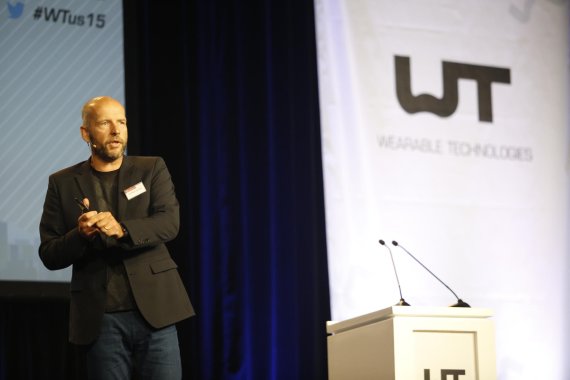
Sales of fitness trackers are already going strong, and watch manufacturers have identified smartwatches as the market of the future. Stammel compares the opportunities for wearables to the growth curve of the Internet: However, he says, the technology is still in its infancy. He spoke with ISPO.com about the prospects for wearables and why the technology still looks like computers did in 1995.
Mr. Stammel, wearables are booming, but the technology still has room to grow. Where does the wearable market stand?
Christian Stammel: Most of the technologies used in WT products today already existed 10 years ago, but only now have standards such as Bluetooth and Bluetooth low energy become established. With this standardization, you have a platform with every smartphone that makes it very easy to connect smart things and you can also connect wearables. But I also have to say that the entire market is still in an early phase, an "early stage".
In 1994, hard drives were no bigger than around 2 gigabytes. In 1996, a four-gigabyte hard drive cost around 1800 marks. Today, a 160 GB hard disk no longer costs 30 euros. So how do you mean that exactly?
We always compare the development with the rapid development of the first Internet years from 1994 onwards. Compared with that time, we are roughly in 1995 - in other words, still in the early stages of the Internet with countless opportunities and, of course, risks. But some of the most valuable companies of our time were formed back then. We hope so, of course, with a view to the wearable technologies market.
That is, only in five years will wearables really enter our daily lives?
It will be very difficult to predict which product will have found its way into our daily lives as a wearable in five or ten years. Basically, I assume that wearables will accompany us in every life situation. Ten years ago, no one would have thought that the GoPro would catch on - because no one straps such a box onto their helmet. Today, this product has shaped an entire market, is almost a generic term and the founder is one of the first billionaires in the young wearables market. Even with in-depth knowledge, you can't predict that 100 percent.
Wearables cause problems for watch manufacturers
Is Apple still a pioneer like it was with the Applewatch, or have there been other trends for a long time?
The big advantage with Apple is the user-friendliness, even if the battery life is very short. But that's the basic problem in our industry. Most smartwatches don't run for more than 12, 14 hours. Otherwise, Apple has managed to set a standard in usability. The Apple Watch has not alone greatly changed the whole watch market, but in combination with the numerous other smartwatch manufacturers such as Samsung, Huawei, Sony and many others, the watch market has changed and will change permanently. For example, the U.S. has seen a sharp drop in the market for watches between 300 and 800 euros, and this drop of around 40% is due to the many smartwatches and, of course, in large part to Apple.
Now, however, the watch manufacturers have to follow suit.
Every watch manufacturer will incorporate a smart component in the future. Even if there will certainly still be those who say they want nothing to do with it. But even high-end manufacturers are now increasingly entering the smartwatch market. Companies like TAG Heuer and Casio are selling their watches strongly, just not yet in volumes like the Applewatch. What is already the case, however, is that Apple is having significant success. Not compared to smartphone sales, but compared to the watch market.

But there are still glaring weaknesses like the missing GPS in the Applewatch.
The battery life is also a problem here. The display alone needs a lot of power. If GPS is added, the battery life is reduced even more. In addition, the Applewatch is designed so that it is always connected to the cell phone and uses its GPS data. In this respect, a standalone GPS does not make sense in a watch like the Apple Smartwatch. In pure sports watches that are supposed to record distances without a smartphone, a separate GPS is needed again. As a manufacturer, you have to consider exactly which application scenarios the customer wants and define the components and functions of the watch based on that. Theoretically, it is possible to pack almost all functions into a watch today due to the advancing miniaturization - but then this "super" smartwatch only runs for one hour.
Virtual reality glasses are currently a big hit. Will we all soon have a box in front of our heads?
Immersive 3D glasses have already become an integral part of the gaming industry. The first training applications in the sports sector were also recently shown at ISPO MUNICH with the Icaros project. In the broad mass market, it remains to be seen how this will develop and whether this will become the new 3-D television. Companies like HTC and Facebook are already investing a lot of money in this segment of wearable technologies. This market is definitely a hot topic.
Immersive glasses will be a product of the future
That's where the Google Glass was more suitable for everyday use.
Google Glass was certainly much more suitable for everyday use, but the wearer was always an obvious carrier of this product. Especially in the smart glass market, we assume that solutions will establish themselves in the private sector that are not immediately recognizable to the outsider. For non-glasses wearers in particular, the hurdle of wearing something on the face is great. This is different in the professional environment where protective goggles or other work clothing is worn. But also in special cases like the gaming market, where users are used to interacting with controllers and computer games are usually played within their own 4 walls, different rules apply. A story like the old Google Glass will no longer exist in this form. New solutions from any manufacturer will be highly integrated and will not support the user in a way that is recognizable to outsiders or provide augmented information.
That is why the market for smart glasses is not really growing strongly.
Something is already happening in this area and the market will also grow again. I think we will see the second wave of smart glasses and eye wear in 2018. If you look at what's happening with immersive glasses right now: That's where everyone is racing to the front right now. Epson has played the normal image on the glass, that's going to keep getting better. But sensors can also be integrated into the temples; it doesn't always have to be a head-up display when we talk about smart glasses.
So far, every manufacturer is trying to make their devices intelligent. So how can you sort the wearable market?
Because each marketing channel has different margins or distribution channels, I would divide the market into six categories: Medical, Wellness, Lifestyle & Computing, Sports & Fitness, Industry & Safety, and Fashion. The issue of marketing is not yet solved for many wearables manufacturers. You can't easily sell a sports product in the wellness or fashion market because different structures prevail there and different margins apply. However, many wearables products fit well into the sports market, especially in the fitness and healthcare sectors.
In two further parts, Christian Stammel from Wearable Technologies explains the added value of wearables in sports and how athletes can optimize their health with the small wearable devices.
 SportsTechUnlocking the Future of Sports with AI
SportsTechUnlocking the Future of Sports with AI
- ISPO awards
- Mountain sports
- Bike
- Design
- Retail
- Fitness
- Health
- ISPO Job Market
- ISPO Munich
- ISPO Shanghai
- Running
- Brands
- Sustainability
- Olympia
- OutDoor
- Promotion
- Sports Business
- ISPO Textrends
- Triathlon
- Water sports
- Winter sports
- eSports
- SportsTech
- OutDoor by ISPO
- Heroes
- Transformation
- Sport Fashion
- Urban Culture
- Challenges of a CEO
- Trade fairs
- Sports
- Find the Balance
- Product reviews
- Newsletter Exclusive Area
- Magazine




